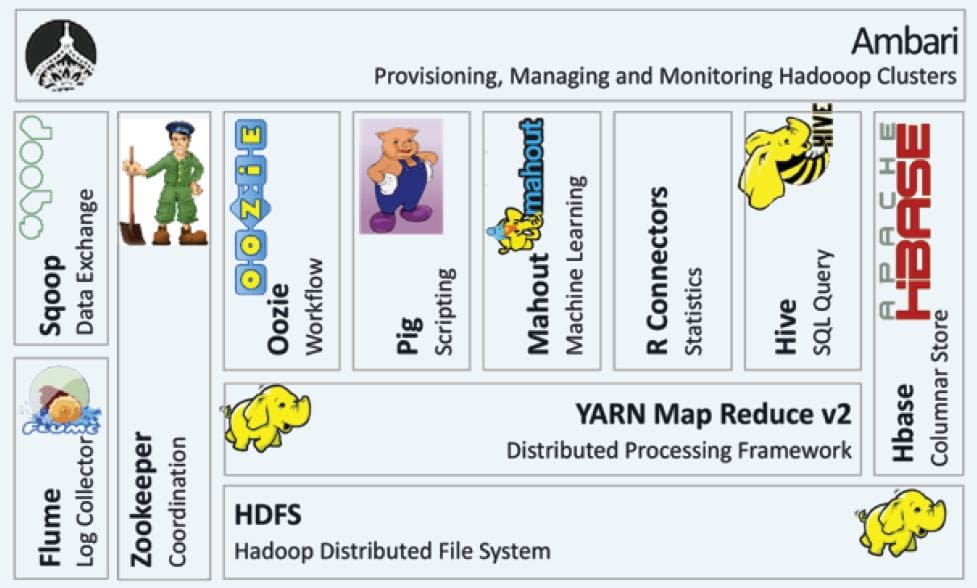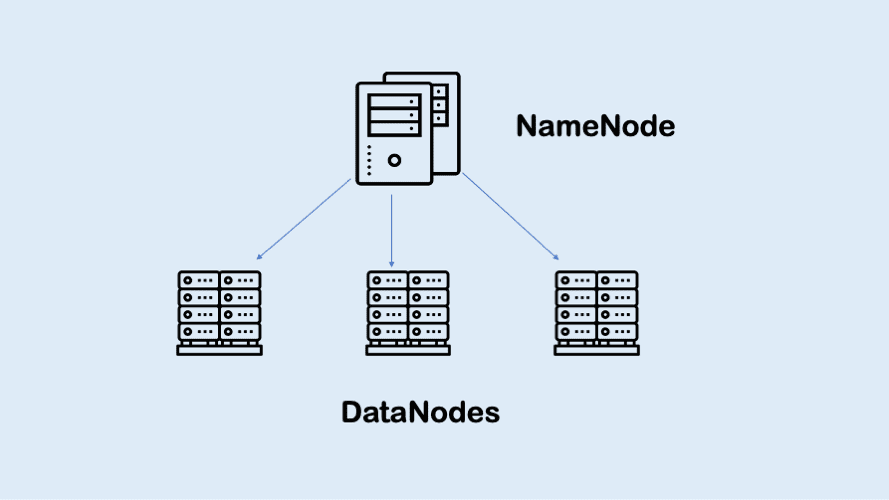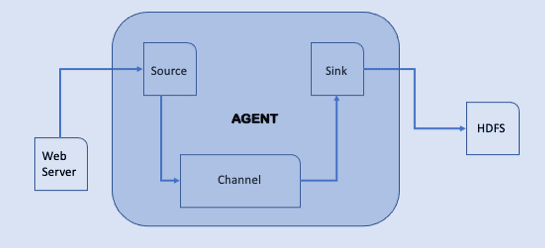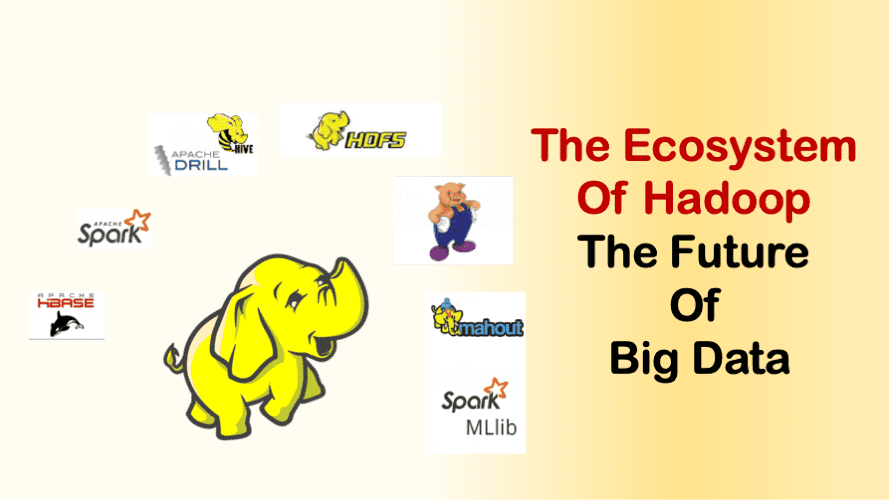Table of Contents
ToggleThe Ecosystem Of Hadoop is not an actual programming language or service, it’s an application or framework that solves big data-related problems. It can be described as a complete suite that includes various services like ingesting data, storing, analysing and maintaining data within it.
Here is a list of Hadoop components, which together make up an ecosystem of Hadoop.
| Hadoop Components | Use-case |
| HDFS | Hadoop Distributed File System |
| YARN | Yet Another Resource Negotiator |
| MapReduce | Data processing using programming |
| Spark | In-memory Data Processing |
| PIG, HIVE | Data Processing Services using SQL like query |
| HBase | NoSQL Database |
| Apache Drill | SQL on the top of Hadoop |
| ZooKeeper | Managing Cluster |
| Oozie | Job Scheduling |
| Flume, Sqoop | Data Ingesting Services |
| Solr And Lucene | Searching & Indexing |
| Ambari | Provision, Monitor and Maintain cluster |
| Spark Mlib | Machine Learning library |


HDFS
Hadoop Distributed File System is the main component, or, as you might say, the foundation of the Ecosystem of Hadoop
HDFS is the only one that allows you to store a variety of massive databases (i.e. semi, unstructured, and organised data).
HDFS provides a degree of abstraction over resources, and from there we can view the entire HDFS as one unit. It assists us in storing our data across multiple nodes, and also in keeping the log file for the data stored (metadata).
HDFS includes two key elements, i.e. NameNode and DataNode.
- NameNode: NameNode is the primary node. It doesn’t contain the actual information. It is a metadata-based node, just as a log file, or as table of contents. This means it needs less storage space and computational power.
- DataNode: The data you have is stored on DataNodes which means it needs additional storage resources. The DataNodes are hardware that is commonly used (like your desktops and laptops) within the distributed system. This is that’s why Hadoop solutions are extremely economical.
It is always a good idea to communicate with the NameNode when you write the data. It then communicates for the client to store and replicate the data across various DataNodes.


YARN
Think of YARN to be the central brain for your Ecosystem Hadoop. It handles all of your processing tasks by assigning resources and assigning tasks.
It is comprised of two elements, i.e. Resource Manager and Node Manager.
- Resource Manager: It remains a key node in this department. It processes the requests, and passes the requests’ parts to Node Managers in the right order which is which is where actual processing happens.
- Node managers: They are present on each Data Node. It is responsible for the execution of tasks on each Data Node.
ResourceManager comprises two parts Application manager and Schedulers.
- Schedulers: Based on your app’s requirements for resources, the Schedulers execute scheduling algorithms and distributes the resources.
- Applications Manager: As Applications Manager is accepting the job application, it negotiates with containers (i.e. the Data Node environment in which the processes are executed) for the execution of the particular Application Master and monitoring the process’s progress. ApplicationMasters are the deamon that are located on DataNode and communicate with containers for the execution of tasks on every DataNode.
MapReduce
It is the main part of processing in the Ecosystem of Hadoop as it provides the processing logic. In the simplest terms, MapReduce is a framework that assists in creating applications that process massive data sets by using distributed and parallel algorithms within a Hadoop environment.
In the MapReduce software, Map() and Reduce() are two different functions.
- The Map function can be used to perform actions like grouping, filtering and sorting.
- The Reduce function aggregates results and summarizes the results created by
Map function. - The output generated using the map function creates the key value pair (K V) that performs
as input to the as the input for the Reduce as the input for the Reduce function.
| Student | Department | Count | (K,V) |
| Student1 | D1 | 1 | (D1,1) |
| Student2 | D1 | 1 | (D1,1) |
| Student3 | D1 | 1 | (D1,1) |
| Student4 | D2 | 1 | (D2,1) |
| Student5 | D2 | 1 | (D2,1) |
Lets suppose above sample data of students as well as their departments. We would like to determine what number of pupils are within each department.
At first, the Map program executes and determine the number of students within each division, resulting in this key-value pair previously mentioned. The key value pair is an input for reduce function. The Reduce function will combine each department, and calculate the total number students from each department to give the result as a result.
| Department | Students Count |
| D1 | 3 |
| D2 | 2 |
What is Hadoop PIG?
PIG was first created by Yahoo.It provides the ability to create a data flows for ETL (Extract Transform, Extract as well as Load), processing and analysing massive data sets.
PIG has two parts: Pig Latin, the language and the pig runtime, for the execution environment. It is better understood by referring to it as Java as well as JVM. It supports the pig latin language that includes a SQL similar command structures.
But you shouldn’t get surprised when I tell you that at the end of a Pig job the map-reduce task is executed.
The compiler internally converts pig latin into MapReduce. It creates a sequence of MapReduce jobs. This is an abstraction (which functions like a black box).
How is PIG used?
In PIG, we first use the load command loads the data. After that, we perform various tasks using it such as
grouping and joining, filtering and more. Finally, you can display the result onto the screen, or
you could store the results in HDFS.
What is Hive Hadoop?
Facebook has created HIVE for those who are proficient in SQL. Therefore, HIVE helps them feel at the right place while working within a Ecosystem Hadoop.
It is basically an application for data warehousing which is capable of reading, writing and managing massive data collections in a distributed environment with an interface that is SQL-like.
HIVE plus SQL + SQL = HQL
The language used to query data in Hive is known as Hive the Query Language(HQL) It is very similar to SQL.
It is composed of two elements: Hive Command Line and JDBC/ODBC driver.
The Hive Command line interface is utilised to perform HQL commands. Additionally, Java Database Connectivity (JDBC) and Object Database Connectivity (ODBC) is used to establish connections to storage of data.
Additionally, Hive is highly scalable. It can be used for both goals, i.e. large data set processing (i.e. batch query processing) and real-time processing (i.e. Interactive query processing).
It is compatible with all data types that are primitive to SQL. It is possible to use predefined functions or write user-defined functions (UDF) in order to meet your needs.
APACHE MAHOUT
Mahout offers a platform to develop machine learning software that can be scaled. Machine learning algorithms enable the creation of self-learning systems that learn by themselves without having to be explicitly programmed.
Based on the user’s behavior patterns, data and previous experiences, it can make crucial choices. It can be described as an ancestor from Artificial Intelligence (AI).
What exactly does Mahout does?
Mahout is a collaborative filtering system as well as clustering and classification. There are those who consider the frequent absence of items as Mahout’s purpose. Let’s look at them in isolation
- Collaboration-based filtering Mahout analyses the user’s behaviour, their patterns and specific characteristics. Based on that, it makes predictions and provides recommendations to users. The most common use case is an online store.
- Clustering: It arranges the same set of information, such as articles. It may include news, blogs research papers, and blogs.
- Classification: It is the process of separating and categorising information into different categories like articles. They can be classified into news, blogs and essays, research papers and many other types of.
- A frequent item that is missing: This is where Mahout examines which items will likely to appear together and offer suggestions when they’re not. For instance, cell phones and case are linked generally. If you search to find a phone Mahout will also suggest the case and cover.
Mahout offers the command line that can invoke different algorithms. Mahout comes with an already-defined set of libraries that includes different built-in algorithms that can be used in various scenarios.
APACHE SPARK
Apache Spark is a framework that enables real-time data analytics using a distributed computer platform. It is Spark program is written using Scala and was created at the University of California, Berkeley.
It runs in-memory computing to speed up Data processing in MapReduce. It’s 100x more efficient than Hadoop for large-scale data processing, thanks to the in-memory computing capabilities and other optimizations.
This means it requires more processing capability as opposed to Map-Reduce. As you will observe, Spark comes packed with high-level libraries that include the support of R, SQL, Python, Scala, Java etc.
These libraries are standard and allow for seamless integration of complex workflows. In addition, it lets a variety of different services to connect with it, such as MLlib, GraphX, SQL + Data Frames and Streaming services to enhance its capabilities.
Apache Spark best is suited for real-time processing in contrast to Hadoop which was developed to store data that was not structured and then perform batch processing over it.
When we combine Apache Spark’s capability, i.e. speedy processing, advanced analytics and multiple integration capabilities together with the low-cost operation of Hadoop on hardware of a commodity It delivers most of the best results. This is the reason, Spark and Hadoop are employed by numerous businesses to process and analyze the Big Data stored in HDFS.
HBASE
HBase database is an open-source non-relational distributed database. It is an NoSQL database. It is able to handle all types of data, which is the reason it is capable of handling any and everything in an Hadoop ecosystem.
It’s modelled on Google’s BigTable which is an open storage system that was designed to deal with huge datasets. The HBase was created to be a part of HDFS and offers BigTable similar capabilities. It offers us an error-tolerant method to store data that is not very large that is typical for the majority of Big Data use cases.
The HBase program is written in Java and HBase applications can be written using Avro, REST, or Thrift APIs. For better understanding, Let us take an example.
There are millions of customer emails, and you have to figure out the number of customers that uses the word “complaint” within their email. The request should be handled swiftly (i.e. in real-time). This means that we’re dealing with a huge dataset while retrieving only just a few bits of data. To solve these kinds of issues, HBase was designed.
APACHE DRILL
Apache Drill is used to search for any kind of data. It’s an open source program that works in a distributed environment for analysing large amounts of data. It’s a clone that of Google Dremel.
It can work with different types of NoSQL database and file systems which are an important characteristic of Drill. For instance: Azure Blob Storage, Google Cloud Storage, HBase, MongoDB, MapR-DB HDFS MapR-FS Amazon S3, Swift, NAS and local files.
In essence, the primary purpose of Apache Drill is to provide the ability to process exabytes or petabytes of data quickly. The power behind Apache Drill lies in combining various data storage systems with one query. Apache Drill basically follows the ANSI SQL.
It has a significant capacity factor for scalability that can support thousands of customers and serving queries on large scale data.
ZOOKEEPER
Apache Zookeeper acts as the coordinator for any Hadoop job that requires the combination of several services that make up the Ecosystem of Hadoop. Apache Zookeeper coordinates with various services in a distributed.
Prior to Zookeeper was introduced, it was complicated and time-consuming to coordinate with various services within the Ecosystem Hadoop. The earlier services had numerous issues with interactions, such as common configurations when synchronising data. Even when the services are set up, changes to the settings of the services makes the process difficult and complex to manage. Naming and grouping of services was also a time-consuming issue.
Because of the issues mentioned above the introduction of Zookeeper. It can save a lot of time by performing synchronisation, grouping, configuration maintenance and the naming. While it’s a basic service, it’s used to develop effective solutions.
APACHE Oozie
The APACHE Oozie service is a good example. Apache Oozie as a clock and alarm service within the Ecosystem.of Hadoop. In the case of Apache job, Oozie has been just as a scheduler. It plans Hadoop jobs and joins them as a single task.
There are two types of jobs that Oozie can handle:
1. Oozie workflows They are a sequence of tasks to be completed. You could think of it as the relay race. In which each participant waits until the last athlete is ready to complete their part.
2. Oozie Coordinator Oozie Coordinator: These Oozie Coordinators are Oozie jobs that get activated when data is provided to it. Imagine this as the response stimuli system that is present in our body. Similar to how we respond to external stimulus, the Oozie coordinator reacts to the data available and does not work in a different manner.
APACHE FLUME
The APACHE FLUME service is a vital component of the Ecosystem of Hadoop. Flume can be described as a program that assists in the ingest of unstructured and semi-structured information into HDFS.
It offers an option that is secure and spreads out, which aids us with collecting the data, aggregating it and moving an enormous quantities of data. It assists us in ingesting streaming data on the internet from various sources such as social media, network traffic emails log files, and so on. to HDFS.
Let’s look at the structure of Flume by looking at the diagram below It is an Flume agent that ingests streaming data from different sources and then transfers it to HDFS. Based on the diagram, one will be able to see that the website server identifies the source of data. Twitter is the top sources of streaming data.
Flume is a software that has three parts that are source, sink, and channel.
- Source: it receives information from the streamline and stores the information in the channel.
- Channels: they function as the local storage, or primary storage. A channel is a temporary storage that is located between the data source and persistent data stored in the HDFS.
- Sink: Our final component, i.e. Sink, gathers information from the channels, and then commits and writes it into HDFS. HDFS permanently.


SQOOP
The primary distinction in Flume as well as Sqoop is that Flume only ingests unstructured or semi-structured data to HDFS. However, Sqoop can import and export data structured to and from RDBMS as well as Enterprise databases to HDFS or reverse the process.
When we send Sqoop request, the primary task is divided into sub-tasks that are performed by each Map Task internally. The Map Task is the sub-task that imports a portion of the data into it’s Hadoop Ecosystem. Together the entire set of Map tasks import the entire data.
Export functions in the same way. Once we submit our Job it’s mapped into Map Tasks which then bring the data chunk from HDFS. The chunks are then exported to an organised data destination. When we combine all the exports and we get the complete information at the destination which is in many instances an RDBMS (MYSQL/Oracle/SQL Server).
Apache SOLR and LUCENE
Apache Solr as well as Apache Lucene are two services that are utilised to search and index data in the Hadoop Ecosystem.
Apache Lucene is based on Java and also assists with spell-checking. When Apache Lucene is the engine, Apache Solr is the vehicle built around it.
Solr is a full-featured application that is built on Lucene. It makes use of its Lucene Java search library as an essential component for searching and indexing in full.
AMBARI
Ambari is an Apache Software Foundation Project which seeks to make the ecosystem Hadoop easier to manage. It is a software solution for provisioning, managing , and managing Apache Hadoop clusters. Ambari offers: Ambari includes:
- Hadoop cluster-based provisioning. It provides us with a an easy step-by-step procedure for installing Hadoop services across a variety of hosts. It also manages the configuration of Hadoop services across the cluster.
- Hadoop group management is central management services for beginning, stopping and re-configuring Hadoop service across the whole cluster.
- Hadoop Cluster monitoring To track the health of the cluster and its status, Ambari offers an overview. Amber Alert framework Amber Alert framework is an alerting system that alerts the user whenever attention is required. For instance when a node is down, or there is low disk space on a server or any other reason.
Conclusion
In closing, I’d like to focus your attention to three aspects important:
1. Ecosystem Hadoop owes its success to the entire developer community and a variety of big corporations such as Facebook, Google, Yahoo, University of California (Berkeley) and many more. have played a part in helping improve the capabilities of Hadoop.
2. In the Ecosystem of Hadoop, knowledge about two or three devices (Hadoop components) is not helpful when developing an answer. It is essential to know the various Hadoop components that work in conjunction to construct the solution.
3. Based on the scenarios Based on the use cases, we can choose the appropriate set of services from the Ecosystem Hadoop and create a custom solution to meet the needs of an organisation.
Got a question or just want to chat? Comment below or drop by our forums, where a bunch of the friendliest people you’ll ever run into will be happy to help you out!




